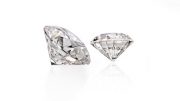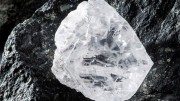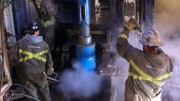As Stornoway Diamond (SWY-T) makes progress on the all-weather road that will give it the access it needs to begin construction at its Renard diamond project in north-central Quebec, the junior has released some good news that will likely boost the project’s value.
The first valuation of diamonds from the Renard 65 kimberlite has shown the quality of its diamond population is “different and generally better” than the three kimberlites that are already in the Renard mine plan.
A March valuation of a 997-carat parcel of diamonds from Renard 65 by WWW International Diamond Consultants produced an average price of US$250 per carat. The average value was somewhat skewed by two high-value stones: a 9.77-carat G-colour stone worth US$8,500 per carat, and a 6.4-carat F-colour diamond valued at US$5,900.
For that reason, WWW has modelled a diamond price of US$180 per carat for Renard 65, with a high and low cases of US$203 and US$169 per carat.
This new information should allow Stornoway to add new open-pit resources and extend the mine life of Renard. The large, high-quality diamonds Stornoway has recovered during each stage of exploration also bode well for the mine.
In a press release, Stornoway president and CEO Matt Manson said that the information prompted the company to take another look at its valuation models, which assumed that the various pipes at Renard all contain samples of a single diamond population.
WWW has recommended using individual price models for each pipe, with the small but observable differences in quality and size distribution treated as real.
This has the effect of lowering prices that can be expected from the Renard 3 and 4 kimberlites, but increasing modelled prices for Renard 2, which contains 83% of reserves. Renard 2 diamonds are now modelled at US$190 per carat, up from US$182 per carat.
Renard 3 and 4 diamonds are modelled at US$151 and US$104 per carat, down from US$183 and US$112 per carat, respectively.
Renard 65 currently contains an inferred resource of 3.7 million carats in 12.9 million tonnes grading 29 carats per hundred tonnes. Reserves at the project, which are contained in the Renard 2, 3 and 4 kimberlites, come to 17.9 million carats in 23.8 million tonnes grading 75 carats per hundred tonnes.
The valuation also provided a gauge on current diamonds prices, which fell substantially in 2012, but have recovered in the first quarter. In March, prices for Renard diamonds were estimated to be about 7-8% lower than the May 2011 prices used in the project’s November 2011 feasibility study.
Construction update
Stornoway received the major permit needed to build Renard (the certificate of authorization) in December, and got its first vehicle access to the project in mid-February, via an ice-road built by the ministry of transportation. Stornoway was able to truck in construction equipment and fuel, and the company reported in March that it had already finished building camp accommodations for 100 people, and shipped in building materials for the all-weather mining road it is building.
The road should provide vehicle access to Renard in the fourth quarter.
The province had previously been responsible for building the road, but the Quebec government announced a spending review of major spending projects, such as the Route 167 extension, last fall. Stornoway stepped in so its construction and production schedule at Renard wouldn’t be delayed.
The company came to an agreement with the province’s ministry of transportation to complete 97 km of a 240-km road that will eventually link Renard to the Quebec highway system. The ministry is completing 143 km of the road as a 70-km-per-hour, two-lane highway, while Stornoway is completing two northern sections as a 50-km-per -hour single-lane mining road. Of the ministry’s southern section, 109 metres were already complete in mid-November.
The cost of the northern sections is estimated at $77 million (including a 15% contingency) and will be funded by a government loan to Stornoway.
The final hurdle to production will be funding. An optimization study released in January, reduced preproduction capital costs at Renard by $50 million to $752 million, while increasing operating costs by $2.92 per tonne to $57.63 per tonne. The major change to the mine plan is that Stornoway will use an enlarged decline to access underground reserves, instead of a shaft and a decline.
Stornoway secured a mandate letter with a consortium of banks In September for a loan of $475 million, and Investissement Quebec, a 25% shareholder in Stornoway, has committed $100 million toward construction.
Shares in the junior recently traded at 64¢ in a 52-week range of 45¢-99¢. The company has 139.7 million shares outstanding.




Be the first to comment on "Full speed ahead for Stornoway at Renard"